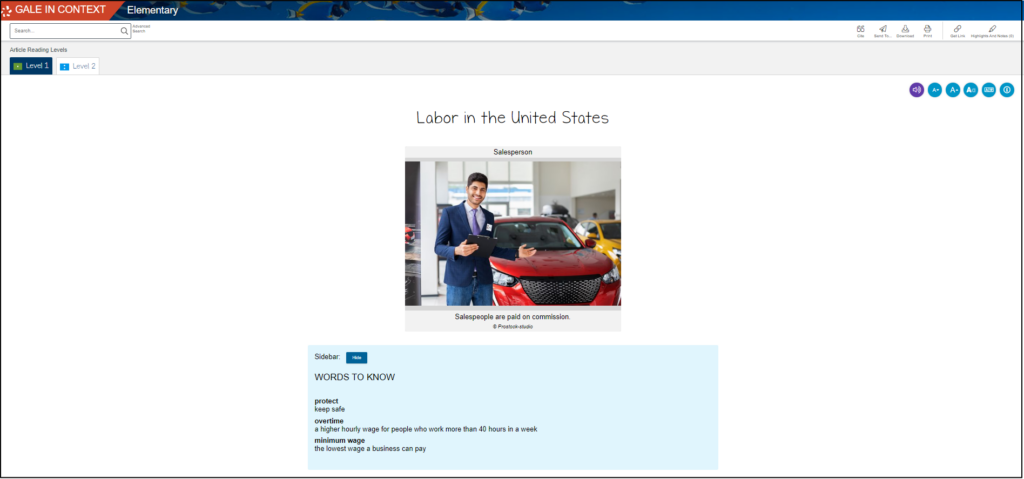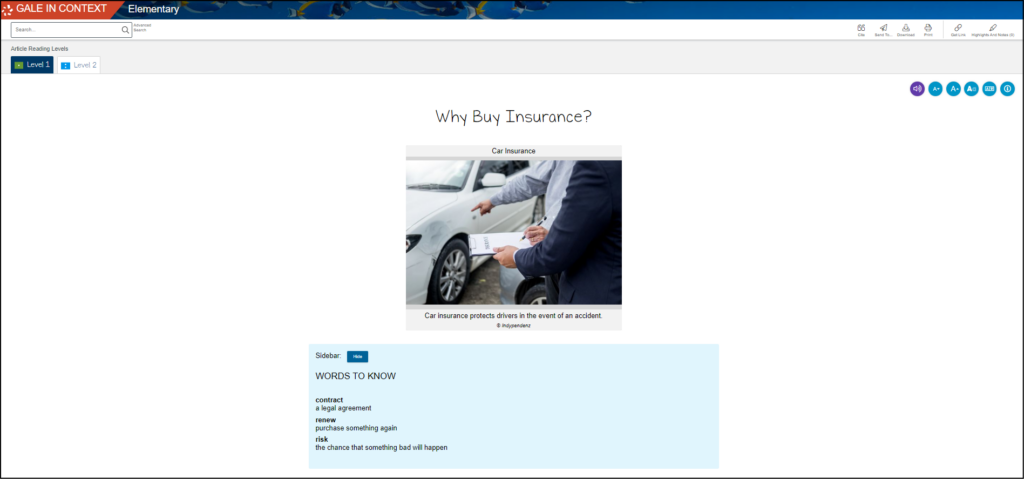| By Elizabeth Mohn |
Many people recognize the benefits of teaching financial literacy to adults and young adults, but fewer understand that young adults and children can also gain knowledge and skills through financial literacy. In the United States, the Council for Economic Education (CEE) and the Jump$tart Coalition have together developed financial literacy standards to help educate K-12 students about the basics of personal finance. These standards are meant to help students build knowledge and improve their decision-making. The standards are broken down into six topics: earning income, spending, saving, investing, managing credit, and managing risk.
Although these topics and their corresponding standards can help guide educators and other adults in teaching financial literacy to students, some adults may still struggle to find engaging content that teaches financial literacy to young students. Gale In Context: Elementary has a wide range of new articles focusing on financial literacy standards. The articles are aligned to the standards that the CEE and the Jump$tart Coalition developed, and address many aspects of the six main financial literacy topics the standards cover.
The first topic covered by the standards is earning income. Although students in elementary school will be unlikely to earn a significant income for many years, Gale In Context: Elementary has age-appropriate articles that can help them better understand how and why people earn income. For example, the article “Labor in the United States” helps students learn how people earn wages through work. Teachers can also gain students’ interest in the topic by exploring articles such as “What Kinds of Jobs Are There?” and “My Career,” which will help them understand the careers and jobs they may want to pursue in the future and the actions they will need to take to do that. Some students may be interested in earning money for themselves before entering a full-fledged career. They may be interested in “Jobs for Kids” to learn about jobs they can do when they are young. Students can also read “Starting a Business” to understand what steps they need to take to create their own business.
Students who understand the basics of earning money can better understand what people do with their money. One of the most common actions people take with money is spending it, and spending is another important financial literacy topic. Teachers can help introduce students to the concept of spending with the article “Managing Your Money.” This describes how to make a spending plan, or a budget. Teachers might also encourage students to explore the article “Spending Goals,” which discusses how goals help consumers spend wisely. The article “Comparison Shopping” introduces another tool consumers can use to ensure they’re spending wisely. In addition, teachers can help students understand how outside forces can influence spending by encouraging them to read the article “Product Advertising.”
After students have learned about spending money wisely, they can learn about saving, another essential action people take with money. Students can better understand the basics of saving money, including why and how people save, in the article “Saving for the Future.” The article “Emergency Savings” provides students with more information about why saving is beneficial. Those interested in saving money on their own or learning about how others save money can also read “Helping You Save.” This article suggests that children can save money in a particular place, such as a piggy bank, or have their parents open bank accounts for saving.
Another important topic covered by the financial literacy standards is investing, and the database includes many articles educators can use to teach the concept. For example, the article “Saving vs. Investing” can help students understand the similarities and differences between saving and investing, and it can help them understand people’s motivations for investing. Students can also learn about some of the possible negative consequences of investing in the article “Investment Risks,” whichcan help them realize that investing usually involves risk. From the article, students will learn that investing large amounts of money could result in significant benefits or cause considerable losses.
Learning how to spend, save, and invest wisely can help students make better decisions now and in the future. Teachers can help students make good decisions regarding credit and risk by helping them learn about those financial literacy topics too. The concept of using and managing credit may seem advanced for some elementary students, but helping them understand the use of credit and its possible risks can help them know when and how to use credit in the future. The article “Spending Now or Later?” helps students understand more about this topic. Students might also be interested in the article “Lending Money,” which tells what organizations generally lend money to borrowers and describes people’s motivations for lending.
The final topic the financial literacy standards cover is managing risk. The Gale In Context: Elementary database contains numerous articles about financial risk and ways to avoid or deal with it. Students can better understand the basics of financial risk with the article “What Is Risk?” Teachers who want students to learn about risk, including possible outcomes of risks, can encourage them to read the article “Losing Treasures.” This article explains that people can lose valuable items through theft, loss, or damage. The article “Why Buy Insurance?” can help interested students understand that insurance is one way people manage financial risk.
The CEE and the Jump$tart Coalition note that while it’s vital for children to learn financial literacy at home, some who could most benefit from financial literacy education may not have the opportunity to learn about it there or with loved ones. The organizations, therefore, stress that their members encourage educators to make financial concepts part of everyday classroom teaching. Teachers can make this process simpler and more enjoyable by accessing the numerous resources now available in the Gale In Context: Elementary database.


About the Author
Elizabeth Mohn is a writer and an educational content developer. When she’s not reading or writing, Elizabeth is usually spending time with her family, listening to podcasts, or working in her garden.




